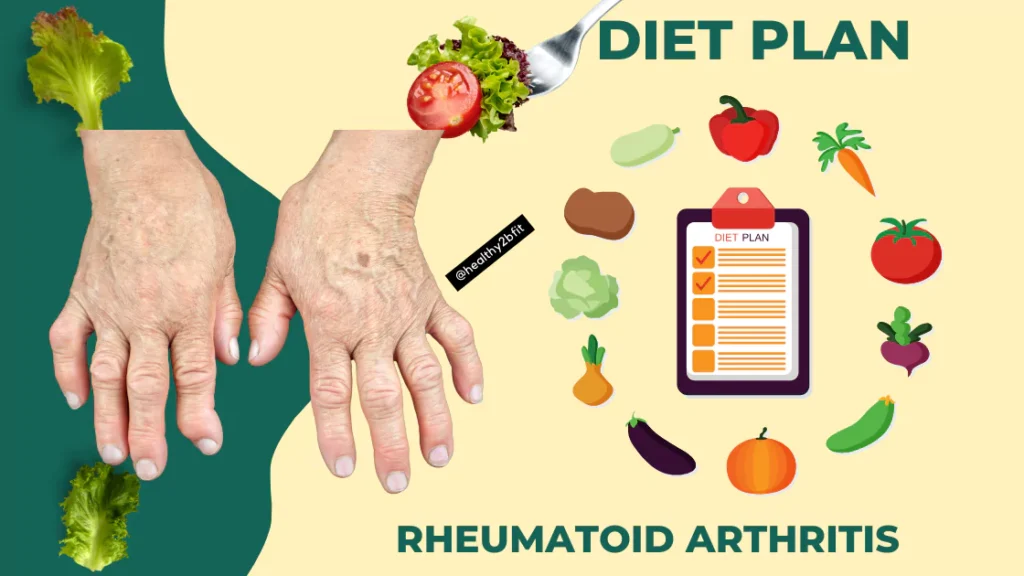Diet Plan for Rheumatoid Arthritis
Food as Medicine – Manage Rheumatoid Arthritis with a Specialized Diet Plan
Proven Diet and Nutrition Plans to Help Reduce Inflammation and Pain
Our diet plans are solely based on natural foods that support joint health and help manage the symptoms of rheumatoid arthritis.
Why Diet is Crucial in Managing Rheumatoid Arthritis
Rheumatoid arthritis (RA) is an autoimmune disorder that causes inflammation and pain in the joints. Proper nutrition is key to managing RA symptoms. At Healthy2Bfit, we create customized diet plans that focus on reducing inflammation and supporting joint health, making it easier to live with Rheumatoid Arthritis
What You Will Get From Our Rheumatoid Arthritis Diet Plans

Inflammation Control
Incorporates anti-inflammatory foods that help reduce pain and swelling.

Joint Support
Focus on nutrients that aid in maintaining joint health and flexibility.

Personalized Plans
Diet plans tailored to fit seamlessly into your lifestyle without major habit changes.

Expert Advice
Guidance from experienced dieticians specializing in rheumatoid arthritis.
How Our Rheumatoid Arthritis Diet Program Works

Initial Consultation
First up, we discuss your health status, dietary habits, and goals with our dieticians.

Personalized Diet Plan
Then we give you a diet plan focused on foods that help manage rheumatoid arthritis.

Regular Follow-ups
We continue providing support and adjustments to your diet plan as needed.

Ongoing Support
We assist in managing your arthritis through diet and lifestyle changes.
Sample Rheumatoid Arthritis Diet Plan
Day 1 Example:
Breakfast: Ragi porridge with walnuts and a drizzle of honey.
Mid-Morning Snack: A bowl of mixed seasonal fruits (such as papaya, pomegranate, and apple).
Lunch: Brown rice pulao with mixed vegetables and a side of sprouted moong salad.
Evening Snack: Cucumber and carrot sticks with mint chutney.
Dinner: Grilled fish (tandoori style) with brown rice and then sautéed spinach (Vegetarian option: Grilled paneer with brown rice and sautéed spinach).
Note: Each diet plan is customized to meet your specific health needs.

Success Stories from Our Clients

Neeraj Sharma

Roop Matharoo

Rajni Kamboj

Pooja Mahajan

Lakhwinder kaur

Kirti Wandile-Chandankhede

Gurpreet Ghumaan

Daman Bindra
Day 1 Example:
Breakfast : Ragi porridge with walnuts and a drizzle of honey.
Mid-Morning Snack : A bowl of mixed seasonal fruits (such as papaya, pomegranate, and apple).
Lunch : Brown rice pulao with mixed vegetables and a side of sprouted moong salad.
Evening Snack : Cucumber and carrot sticks with mint chutney.
Dinner : Grilled fish (tandoori style) with brown rice and sautéed spinach (Vegetarian option: Grilled paneer with brown rice and sautéed spinach).
Note: Each diet plan is customized to meet your specific health needs. Connect with us on Facebook now!
Targeted Nutrition to Improve Your Rheumatoid Arthritis
Talk to us on Instagram!
Get a blueprint to manage Rheumatoid Arthritis with our customized diet plans.
Book Appointment Contact UsFrequently Asked Questions
Yes, a proper diet can help reduce inflammation and support joint health, which may alleviate some symptoms of rheumatoid arthritis.
Our diet plans include anti-inflammatory foods and nutrients that support joint health, tailored to your preferences.
Yes, we provide guidance on foods to avoid that may trigger inflammation or worsen RA symptoms.
We will regularly review and update your diet based on your progress and any changes in your condition.
